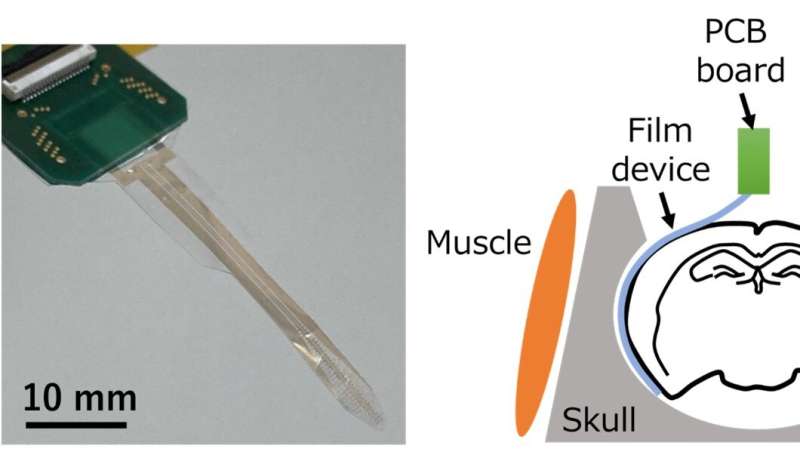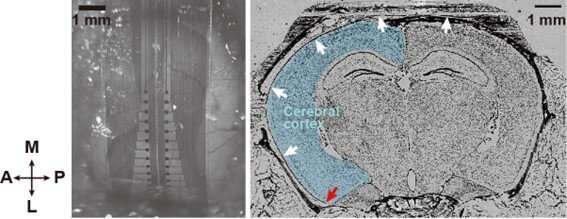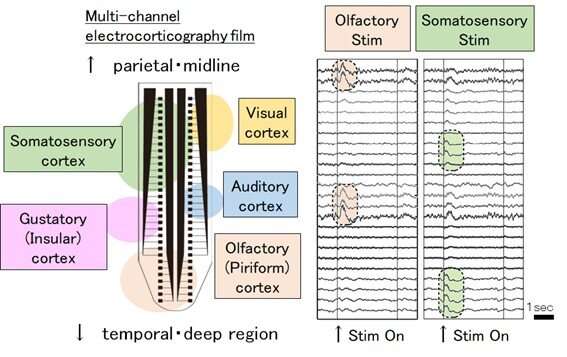This article has been reviewed according to Science X's editorial process and policies. Editors have highlighted the following attributes while ensuring the content's credibility:
fact-checked
trusted source
proofread
Scientists achieve multisensory information detection over a wide area of the cerebral cortex in mice

A multi-institutional collaborative has developed a flexible electrocorticography film for simultaneous detection of multisensory information from multiple regions of the cerebral cortex by placing neural electrodes over a wide area of a mouse brain surface.
Researchers believe that the human brain achieves cognitive functions such as attention, learning and memory through the simultaneous processing and integration of sensory information across multiple regions of the cortex. In order to understand the neural information processing mechanisms underlying these cognitive functions, researchers required a device capable of simultaneous recording neural activity from a wide area of the cerebral cortex, including the temporal region responsible for processing diverse sensory information in rodents such as mice and rats. However, the placement of such a device posed challenges due to the obstruction of the temporal region in a rodent's head caused by the skull and surrounding temporal muscles.
Therefore, in order to successfully position an electrocorticogram recording device in the temporal and deep regions of the cerebral cortex of mice, it was crucial to develop a device and establish a technique which allows recording electrodes to be placed in the narrow gap between the skull and the surface of the cerebral cortex.
The research group achieved two significant advancements, 1) development of a cortical electrocorticography device composed of an appropriate film that exhibits both flexibility and rigidity for attached to the brain, and 2) establishment of a surgical technique for effectively attaching the device to the temporal region of the brain. As a result, these advancements allow to successfully detect neural activity in the cerebral cortex that was evoked by somatosensory and olfactory stimuli.
This novel electrocorticography device has achieved a wider range of neural activity measurements compared to existing techniques. Moving forward, the method is anticipated to contribute to advancing research on large-scale electrocorticography, facilitating a better understanding of the functional interaction among different brain regions and their mechanism.
The research was published online in the journal Molecular Brain on May 3, 2023.

Conventional microscope-based large-scale calcium imaging and electrophysiological techniques for measurement of brain activity in rodents have been limited to the parietal area of the rodent head due to the hindrance caused by the thick skull and surrounding temporal muscles. Therefore, researchers needed to develop a novel device that can simultaneously detect a wide range of multisensory information from the cerebral cortex including the temporal region, and to establish technology for placement of that device.
With the goal of developing a multi-channel electrocorticography device that can cover a wide area of the brain, this research group proposed the concept of inserting an electrocorticogram measurement device into the narrow gap between the mouse skull and the dura mater. In order to achieve this, the device needed to have both flexibility and rigidity to enable adherence to the brain surface.
The research group addressed this requirement by selecting the appropriate width and thickness of the parylene film, which serves as the base of the device, and by establishing a surgical technique for placing the film in the temporal region. As a result, the research group successfully positioned multi-channel electrodes across a wide area extending from the somatosensory cortex to the deepest part of the cerebral cortex, known as olfactory cortex.
Furthermore, by using an electrocorticography device equipped with 64-channel recording electrodes, the group achieved electrocorticogram measurement from a wide area of the cerebral cortex of awake and anesthetized mice. The research group also confirmed that the developed device, along with its placement technique, can detect neural responses evoked by both somatosensory and olfactory stimuli in the same mouse, thereby enabling simultaneous detection of widely distributed multisensory information in the brain.

Future outlook
The developed multi-channel electrocorticography device technology holds great potential for application across a wide range of mouse brains. This is a novel measurement technology that expands the scope of electrocorticogram recording in the rodent cerebral cortex beyond the previous limitations. Until now, electrocorticogram measurement from the cortical surface of the temporal region was limited to humans and monkeys. However, this innovative technology will enable electrocorticogram measurement even in mice across a wide range from the parietal region to the temporal region.
Through genetic engineering technology, transgenic animals of valuable disease models for various human conditions have been established. By utilizing the measurement technology developed in this research, it will allow the comparison of human cases with the research findings obtained from disease model animals. Advancing their understanding of the brain mechanism responsible for integrating diverse information in rodents will facilitate the elucidation of the pathological mechanisms underlying human neurological and psychiatric disorders, thereby developing new therapeutic techniques.
More information: Susumu Setogawa et al, A novel micro-ECoG recording method for recording multisensory neural activity from the parietal to temporal cortices in mice, Molecular Brain (2023). DOI: 10.1186/s13041-023-01019-9





















